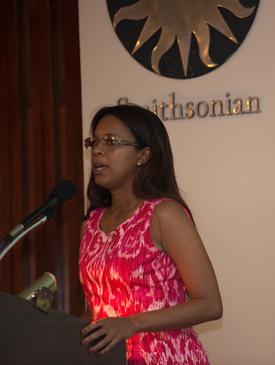Watershed Management for Ecosystem Services in Human Dominated Landscapes of the Neotropics
Summary
Water is an essential element of life that is necessary not only for survival but also for shaping ecosystems, sustaining livelihoods and driving economic development (Stallard et al. 2010, Ogden et al. in review). Over a billion people live in the tropics and rely on forests for their wellbeing, including for drinking water, flood mitigation, energy generation, timber and cultural services. Given that tropical land use change still represents ten percent of global carbon dioxide emissions, land management in the tropics is of concern to everyone. Indeed, continued forest loss coupled with an ever increasing human population requires that we understand and efficiently manage land for ecosystem services (Hall et al. 2011).
While national governments interact with the international community and set national policy, regional and municipal governments, corporations, rural farmers and other stakeholders often make local land use decisions. Engaging the diverse group of stakeholders that manage land can be a challenge, particularly as local stakeholders may question the legitimacy of outside interests (Garen et al. 2009, 2011). Governments have significant experience managing public lands, particularly with regard to protected areas. However, the challenge increases exponentially with the shift from public to privately managed lands all, or in part, for the greater good of society. One challenge simply can be defining the boundaries of the management unit.
Watersheds link rural lands to urban centers by virtue of the incoming water exiting, in part, downstream. Thus, decisions made by rural or industrial farmers, park managers, forest dwellers and managers of hydroelectric dams directly impact the daily lives of downstream residents, especially in urban centers. Conversely, decisions deemed necessary to ensure the quality of life and to fuel the economy downstream can directly impact the livelihoods of residents living upstream, as well as the production of globally essential services such as biodiversity conservation and carbon sequestration.
Many Latin American economies are experiencing an exciting period of growth. However, without careful planning, increasing human populations coupled with activities such as urban and agricultural expansion, roads, mining, and hydroelectric dams will put natural resources at extreme risk. It is therefore essential to understanding the flow of goods and services that come from forests and how they change with land use in order to assure sustainable land management. Watersheds provide ideal biophysical and social boundaries from which to approach natural resource management and planning and the concept of watershed management is on the rise in Latin America.
Content
DAY 1. THURSDAY, MARCH 20
PANEL 1. Land-use effects on ecosystem services
-
Land-use effects on stream flow and water quality: experiences from Agua Salud and Eastern Puerto Rico
Robert Stallard, PhD., US Geological Survey & Smithsonian Tropical Research Institute (STRI) -
Land-use effects on carbon sequestration and diversity in a tropical landscape
Michiel van Breugel, PhD., Yale NUS -
Eco-hydrological impacts of land use and climate change in montane cloud forests: implications for payment for hydrological services programs; Veracruz, Mexico
Heidi Asbjornsen, PhD., University of New Hampshire -
Tropical biodiversity and ecosystem services in fragmented landscapes
Sunshine Van Bael, PhD., Tulane University
PANEL 2. Importance of watersheds for ecosystem services
-
The conservation of the Magdalena River Watershed of Colombia, as a strategy for promoting the connectivity of jaguar populations and its related biodiversity
Esteban Payán, Ph.D., Panthera -
Watersheds: The green infrastructure
Carlos M. Padín, Ph.D., Metropolitan University of Puerto Rico -
Minimizing trade-offs among ecosystem services in multi-functional landscapes
Ciara Raudsepp-Hearne, Ph.D., Independent -
Forest fragmentation influence on ecosystem health: The ecosystem services of bats
Marco Tschapka, Ph.D., University of Ulm
KEYNOTE.
-
Ecosystem services provided by Neotropical forests: advances and perspectives from Latin America
Patricia Balvanera, Ph.D., Autonomous University of Mexico
DAY 2. FRIDAY, MARCH 21
PANEL 3. Approaches to the management of watersheds
-
Participatory research for sustainable agricultural production and ecological restoration
Zoraida Calle, MSc., Center for Research in Sustainable Systems of Agriculture (CIPAV) -
Reforestation and restoration for ecosystem services in watersheds of the humid tropics in Latin America
Jefferson Hall, PhD., Smithsonian Tropical Research Institute (STRI) -
Sustainable livestock in watersheds
Enrique Murgueitio, DVM, Center for Research in Sustainable Systems of Agriculture (CIPAV) -
Approaches in productive landscapes: The Panama Canal Authority’s Program for Environmental Economic Incentives
Arturo Cerezo, Panama Canal Authority (ACP) -
NGO experiences in the management of watersheds
Edgar Araúz, Natura Foundation
PANEL 4. Beyond the watershed
-
Economic tools for valuing conservation and ecosystem services
Jorge Maldonado, PhD., Universidad de los Andes -
Watershed management and governance: How can we get it right?
Daniel Moss, M.Sc., Daniel Moss Consulting -
The importance of integrated management of Panamanian watersheds
Raisa Banfield, Sustainable Panama Foundation (PASOS) -
Scaling models of sustainable conservation through coordination between sectors: the case of the Latin American Water Funds Partnership
Vidal Garza, PhD., Mexican Economic Development (FEMSA)
KEYNOTE.
-
The Panama Canal, the green route of the 21st century
Carlos Vargas, Panama Canal Authority (ACP)


